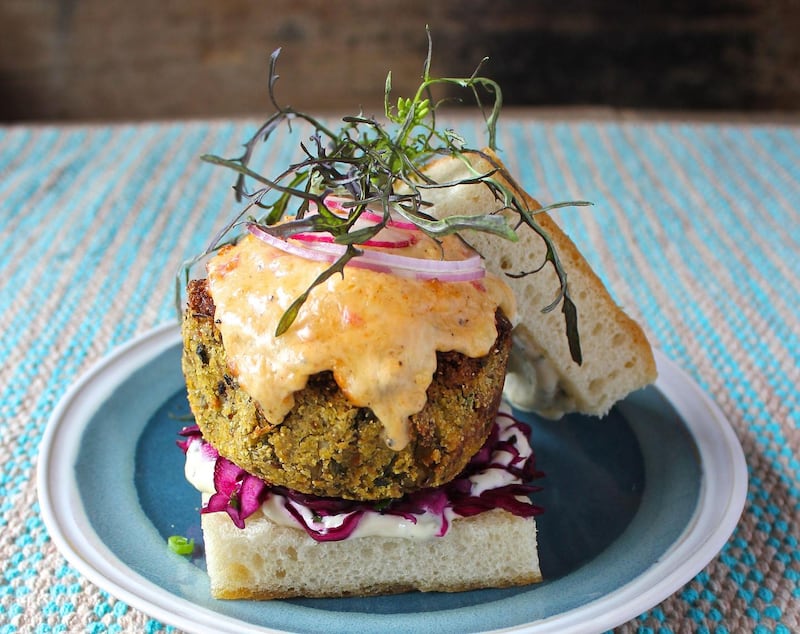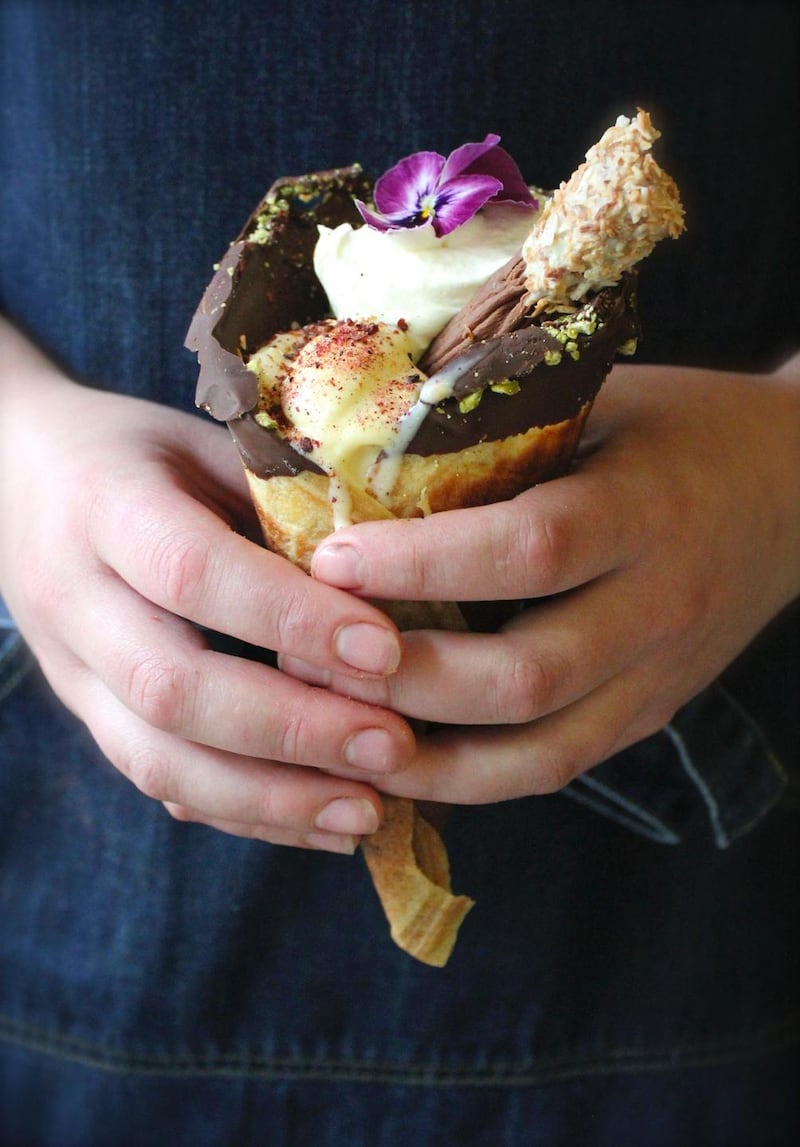If I were a plate of food I'd be ramen or maybe a ball of burrata. Japan feels kind of close to home for me, as it and New Zealand are both in the Pacific. I have two favourite ramen dishes: Hokkaido, topped with butter and sweetcorn, which is ideal for cold, wintry weather; and the one I've chosen for this week's recipe, a quick, sassy Yokohama-style ramen, with pork. We have some pretty amazing free-range pork people in the west, such as Castlemine and Andarl farms. There are no real rules with this noodle dish. It's like a hug in a bowl.
Dave, my husband, and I took a trip to Japan a couple of years back, the same year the whole population of Galway seemed to go. We nailed a few things from the bucket list: going for a meal at Sukiyabashi Jiro, the 10-seat, three-Michelin-star restaurant made famous by the documentary Jiro Dreams of Sushi; visiting the tuna markets; eating miso-covered everything in Kyoto; and eating Kobe beef in its eponymous hometown.
No one on earth does convenience stores like the Japanese. You have to try an ichigo sando (sando is short for sandoitchi, the Japanese word for sandwich), for which you put strawberries and cream between pieces of white sliced pan. My favourite sando is a tamagoyaki one – a kind of rolled omelette – while my good friend Takashi Miyazaki, who owns the newly Michelin-starred Ichigo Ichie, in Cork, prefers a ham katsu one, whose star is its panko-crumbed meat.

For my other two recipes I have a super-tasty mung-bean burger patty for our very own sando, which is popular at Kai, our Galway restaurant. If you can get your hands on a bottle of Kewpie, a brand of Japanese mayonnaise made with rice vinegar, you are sorted.
Then, once you master this no-churn ice cream, you can make your own baked Alaska, any kind of ripple, choc ices: the frozen world will be your oyster. Some other class Christmas combinations can be made so easily, too, such as rum and raisin or Coole Swan and chocolate chip.
‘ROCK STAR’ RAMEN
Ramen is really just a hearty broth pimped up with noodles, toppings and garnishes, all served in a deep, comforting bowl. We make our chicken stock by roasting bones from the Friendly Farmer poultry farm in Athenry. We cook our pork chops on the bone for flavour and to keep the meat from drying out. Kecap manis is Indonesian soy sauce, slightly thicker and sweeter than regular soy; you should find it in any Asian supermarket. If you can't find it, a few spoons of soy mixed with a spoon of treacle will do nicely.
Ingredients
Serves four
For the broth
1200ml of chicken stock
3 garlic cloves, halved
Stick of lemon grass, crushed
4 slices of ginger about the size of a chocolate coin; no need to peel
4tbs tamari
4tbs white miso paste
2tsp dashi vinegar
1 red chilli, finely sliced
2tsp coconut sugar or regular brown sugar
For the rest
A couple of big pork chops (about 300g of meat when taken off the bone)
4tbs kecap manis
4tbs oyster sauce
4 hard-boiled eggs, peeled and halved
300g dried ramen noodles – or four servings, according to packet recommendation
2tsp sesame oil
For the garnish
Sliced green spring onions and whatever is fresh, seasonal and funky. Try a few radishes, some pak choi, a grated carrot or a sprinkle of sesame seeds.
Method
Start with your pork chops. Put the kecap manis and oyster sauce in a zip-lock plastic freezer bag with the chops, making sure the meat is well coated. Seal it up and pop it in the fridge, leave to marinade for at least a few hours and up to three days.
Preheat the oven to 200 Celsius (180 Celsius fan). On a lightly oiled, hot ovenproof griddle pan, fry the pork chop for a few minutes on a high heat on each side until browned. Transfer to the oven to finish cooking through for 10-15 minutes – this will depend on the thickness of the chop. When cooked to your liking, remove and allow to rest for five minutes. Take the meat off the bone, slice on the diagonal and set aside.
In a stockpot or large saucepan, place the chicken stock, garlic, lemon grass, slices of ginger, tamari, miso paste, vinegar, chilli and sugar together and bring to boil. Reduce to simmer for five minutes. Taste the stock and adjust to your liking. If it is too salty, add a little more sugar. Add more tamari if you prefer it saltier.
Cook the noodles in a large pan of boiling water for two to three minutes until just tender or according to the packet instructions. Drain and toss in the sesame oil to prevent them sticking together and divide between four bowls. You can fish out any large pieces of ginger, lemon grass or garlic if you prefer at this stage, then ladle the hot stock over the noodles. Top each bowl with some of the sliced pork, an egg, spring onions and seasonal veggies if using. Allow the veg to slightly wilt before serving.
KAI BEAN BURGER

Ingredients
Makes four burgers
½ cup dry mung beans
1 medium potato, peeled, boiled, and mashed
1tsp grated fresh ginger
1 garlic clove, minced
1 green chillies like serrano, very finely minced
1 small onion, finely minced
½tsp turmeric, optional
1tbs coriander leaves, minced
1tbs mint leaves, finely minced
Few twists of the salt and pepper mills
Glug of olive oil
To serve
Foccacia bread
Pimento cheese
Garlic mayo
Red onion
Method
To make the burger, soak your mung beans overnight or for up to eight hours in enough water to cover them by at least three inches. Drain the beans in a colander, give them a thorough wash and let them sit in the colander, covered with a kitchen towel, until little white shoots appear. If they haven't sprouted yet, rinse them a couple of times a day, once in the morning and again in the evening.
Once the beans have sprouted, cook the sprouts, with just enough water to cover them, for 30 minutes. You want the beans to be al dente and not too mushy. Pulse the beans in a food processor or mash them to break them into smaller pieces, but leave some big bits for texture.
In a large bowl, mix the mung beans with all of the other ingredients. The mixture should hold together when you press it together. Shape four burger patties, patting them out on your palm and shaping the edges with your fingers. Heat a non-stick or cast-iron griddle, add a little oil and cook the burgers over medium-high heat until golden-brown. Flip over and cook on the other side.
Serve with the pimento cheese, garlic mayo and thin slices of red onion. We serve our mung bean burgers on foccacia bread, but they taste great on a good quality sourdough also.
NO-CHURN PASSION FRUIT AND LIMONCELLO ICE CREAM

This is ice cream made easy. No-churns were made popular by Nigella Lawson about 10 years ago. They are simple and creamy, and there's no washing out an ice-cream maker – definitely the way to go. They are just a basic mixture of sugar, cream, condensed milk and whatever flavouring you have to hand. There is nothing like the sunny taste of passion fruit, and everybody who has been on holidays in Italy probably has a dusty old bottle of limoncello around the house. If you don't like this flavour combination, a shot of good espresso, chocolate chips or crushed-up Oreo cookies instead will change your mind. You could find yourself doing a Nigella and eating it in your nightie at 2am.
For the passion fruit curd
200g ripe passion fruit pulp (this will probably be about six to eight fruits, but it will depend on the size)
3 large eggs
250g golden caster sugar
140g butter, diced
2tbs cornflour (optional)
For the ice cream
150g icing sugar
125ml limoncello
600ml cream
200g condensed milk
300g passion-fruit curd
Passion-fruit pulp, waffle cones and chocolate flakes to serve (optional)
Method
Put the passion-fruit pulp in a food processor and whizz for a few seconds to loosen the seeds from the flesh. Transfer into a sieve set on top of a medium saucepan, pushing through as much of the pulp as you can. Reserve two tablespoons of the seeds, more if you like it extra crunchy, then discard the rest.
Add the eggs, sugar, butter (and cornflour if using), to the pulp in the pan and set over a very low heat. Whisk until all the butter has melted and, using a wooden spoon, stir constantly until the curd has thickened – this will take about 10 minutes.
Stir in the reserved seeds and cool completely before adding to the ice cream.
For the ice cream put the icing sugar and the limoncello in a bowl and stir to dissolve the sugar. Add the cream and whip it all together with an electric mixer until soft peaks form. Fold in the condensed milk.
Place some of this mixture into a freezer-proof container and then spread some of the passion-fruit curd on top. Alternate the cream and the curd mixing to get a rippled effect.
It’s a good idea to leave some passion-fruit pulp on top to identify what flavour it is later on. Freeze overnight or until frozen – it doesn’t take very long. Serve in a fancy cone with a chocolate flake.
Any leftover curd can be stored in jars, where it will keep for a week in the fridge. Try it on French toast, pancakes or waffles, or to fill tart shells and top with meringue for a tropical take on that old classic, lemon meringue pie. It also freezes very well.










